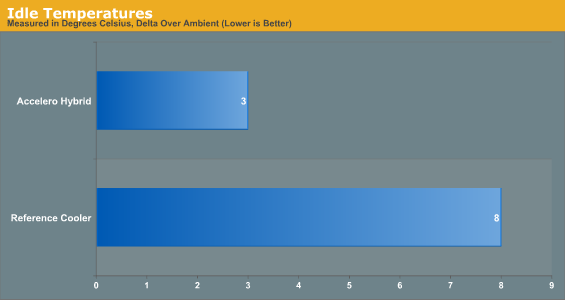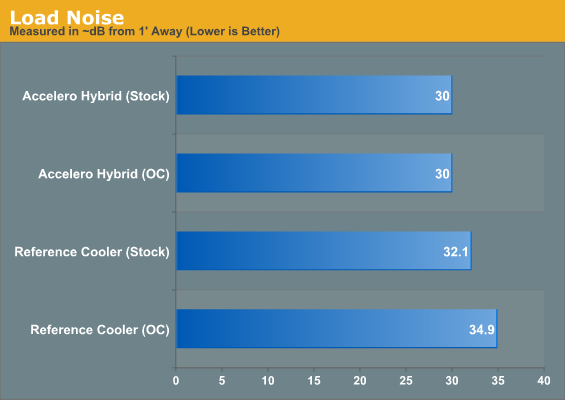Arctic Cooling Accelero Hybrid VGA Cooler Review: Not For the Faint of Heart
by Dustin Sklavos on December 28, 2012 8:15 PM EST- Posted in
- Arctic Cooling
- graphics
- cooling
Performance Results
Of course, for the Arctic Cooling Accelero Hybrid, the proof is in the testing. Once I was satisfied that I hadn't bricked the GeForce GTX 680 during assembly, I went about testing it in eVGA's OC Scanner X software. I've actually been pretty happy with OC Scanner X in personal use, and it generates enough heat to give the coolers a good workout.
I will say that what I found in testing, while not necessarily unexpected, was still pretty impressive.
Ambient temperature during testing was ~21C.

Unsurprisingly, idle temperatures are pretty impressively low for both cooling systems, but already the Accelero Hybrid is able to produce a substantially better result well outside of the margin of error.

Once a load is applied to the card, though, all bets are off. The Accelero Hybrid blows past the reference cooler, producing a massive reduction in thermals. Keep this in mind, I'm going to come back to it later.

Since the reference cooler and Accelero Hybrid both idle below the 30dB floor of our sound meter, idle noise results aren't listed. What's impressive is that the Hybrid is almost dead silent under load, regardless of the increased pressure applied to the cooling system. So while the reference cooler gets louder the harder you push the card, the Hybrid seems to have plenty of thermal headroom to spare.
Using the Arctic Cooling Accelero Hybrid on the GTX 680 has also revealed another interesting wrinkle. While overclocking on the GTX 680 is mostly limited by the Power Target, the reference cooler definitely introduces some thermal limitations. I've seen the GPU clock of the 680 take a step back and begin to throttle a little once it goes north of 70C, but because the Accelero Hybrid has so much thermal headroom, that throttling almost never happens. With the fan control manually maxed out at 85%, I registered a noise level of just 31.3dB in testing, but have actually been able to push the 680 north of 1.3GHz. The stable 6.6GHz clock on the GDDR5 has been consistent between the reference cooler and the Hybrid, but the added headroom for the GPU has allowed me to move past the ~1.2GHz I was able to attain on the stock cooling.
As I've been writing this review, I've actually been steadily testing overclocking on the GTX 680 plus Hybrid by incrementing the GPU Offset +10MHz, running it through OC Scanner X for fifteen minutes (and accepting no artifacts), then benchmarking it in 3DMark 11's Extreme test. This is by no means a thorough stability test, but it's a decent way to poke around the edges of the card's tolerances. I can't imagine how much hotter and louder it would be running with the reference cooler, but with the Hybrid at 85% it's peaking at 63C. That's at 1.3GHz, sustained load.










47 Comments
View All Comments
boyang1724 - Saturday, December 29, 2012 - link
This is quite pathetic actually. Just get an Antec 620/ Corsair H60 cooler and a bracket from dwood for any high end gpu. Also comes with a fan mount, and only costs around $70-80 total. Brought my GTX 670 down from 80C+ max to 55C, and idle from 38C to 25C. It's a much better deal than this thing.SodaAnt - Saturday, December 29, 2012 - link
I'll second this. You get just as much performance for only around $60 (in my case). Plus it actually seems easier to install than this thing.BrightCandle - Saturday, December 29, 2012 - link
A custom water loop specified at 10C delta can produce temperatures around +20C delta at peak load. So these figures are certainly pretty decent comparatively. This goes a long way towards custom loop performance for less cost. Its about the same amount of pain in terms of modifying the GPU for watercooling however, just without the pain of cutting the tubing, fitting larger radiators and other water cooling pain.Your methodology doesn't mention your soak time for the water loop. Due to the heat capacity of water you do need to run at peak load for 30 minutes. So it might not be quite as impressive as it first appears.
mayankleoboy1 - Saturday, December 29, 2012 - link
"Your methodology doesn't mention your soak time for the water loop. Due to the heat capacity of water you do need to run at peak load for 30 minutes. So it might not be quite as impressive as it first appears. "+1
Unless you allow the water temperature to stabilise for some time (1 hour ?) , these results are erroneous.
Death666Angel - Sunday, December 30, 2012 - link
I get ~20K delta between ambient and GPU with my WC rig (4x120mm radiator mounted to the side of the case). It cost me 382.52€, 117.74€ for monitoring and control equipment and 51.56€ for the 4 fans, the rest for the WC stuff (pump, connectors, radiator, tubes...). But I also cool my CPU (which achieved 500MHz higher OC compared to my air cooler (Noctua NH-C12P)) and the system is not audible for me. The GPU was bought used with the WC mounted already and cost as much a new retail, so I got the cooler for free. I can use this equipment for the next CPU, mainboard, GPU upgrade. I can reinstall the stock air cooler on the GPU easily. I can add other components to the loop.I just don't see how these CLCs are seen as competing with custom WC rigs. Yes, they are a bit more expensive, but they also deliver many more options. CLC for CPUs does at least offer a few extra things (better clearance around the socket, extra fan controls...) but I doubt this offers that much more compared to after market GPU air coolers.
ziv_ew - Saturday, December 29, 2012 - link
how dose it compare to the eVGA 680 Hydro Cooper?IanCutress - Saturday, December 29, 2012 - link
Makes me think of the total cost of a pair of MSI Lightnings or ASUS CUII TOPs with these coolers. In simulations the GPU gets hammered extensively over days, and the cooler the whole system the better.dannoddd - Saturday, December 29, 2012 - link
I'd really like to see this put up against one of the DWOOD systems, where you take your choice of ALC mixed with his $8 bracket and put it on any card. I've been concerned about doing it due to the lack of VRM/RAM heatsinks. I think it'd be great if you could grab one of those and bench it against this setup and compare the difficulty of installation.Great article Dustin, love your work.
DanNeely - Saturday, December 29, 2012 - link
As fiddly as this is I suspect that if you've got a supported card a custom loop and a full cover heatsink would be less work to assemble than gluing all the individual ram/vrm sinks in place. Unfortunately they still don't have nVidia 6xx parts available yet.http://www.swiftech.com/graphics.aspx
Shiitaki - Saturday, December 29, 2012 - link
Rather ironic, I had commented in the last water cooling article that the gpu is the one that needs water cooling, not so much the cpu. Why is the radiator mounted to the video card? That's the only reason it's so expensive, and it's silly given how many fan mounts come in cases these days.